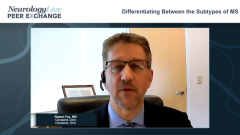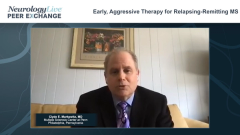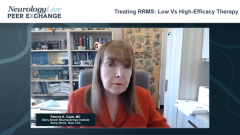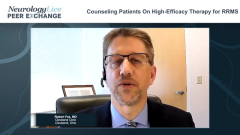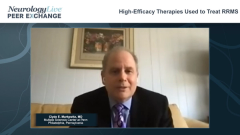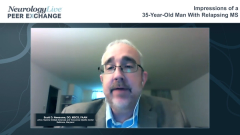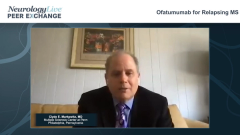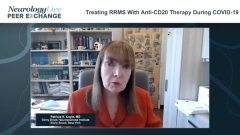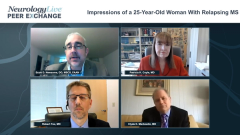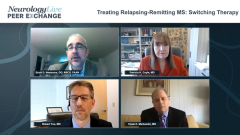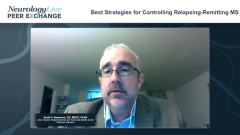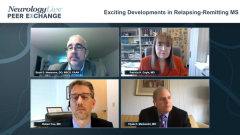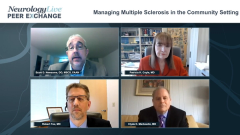
Early, Aggressive Therapy for Relapsing-Remitting MS
The rationale for initiating aggressive therapy early on to treat patients who present with relapsing-remitting multiple sclerosis.
Episodes in this series

Scott D. Newsome, DO, MSCS, FAAN: To me, the group of patients with active progressive disease is a challenging group of patients, especially because they tend to be a bit older and potentially have less neurological reserve to recover from if they have an attack or disability progression. This question always comes up, at least in the patients I see: “Should I go on X medication that may have significant risk associated with it?” This is especially so if the patient is older. Speaking about therapeutics, I am going to punt this back to Clyde because you mentioned early treatments, and you danced a bit around why it is important to implement early treatment. We will focus on relapsing or remitting multiple sclerosis [MS] because that is where all the data are, at least in my view. Can you take us through why it is important?
Clyde E. Markowitz, MD: When you go back to our initial clinical trials in the 1990s, when we took typical patients with relapsing and remitting MS and were able to treat them, some of these patients may have had secondary progressive disease as well. We were able to show that there is a clear benefit with reducing clinical relapses, producing a robust effect that may be even more so on MRI [magnetic resonance imaging] in terms of preventing new lesions. We said that this is a good treatment, and any patient who meets the criteria for relapsing MS should be on these disease-modifying therapies.
As time has gone on for the last couple of decades, we are seeing earlier patients who are being diagnosed to start with. We would have said at some point, “You have not really fulfilled the requirement for the patients who are in the clinical trials in that you do not have a relapsing/remitting course. You have a CIS [clinically isolated syndrome], but you have lesions on your MRI scan. We are not necessarily going to treat you at this point. We will wait and see how things go. If you develop new stuff, then we will put you on treatment.” Then we did the clinical trials and looked to see if, when you took a patient like that and put them on a disease-modifying therapy, how did that affect their course? It was obvious that it had a significant benefit regarding reducing lesions on their scans, time for their next event, etc. These were clear data that we said our CIS population should be treated.
If you take somebody who is early these days, you ask that question. I am going to make a diagnosis of MS. If they meet the 2017 criteria, then I am going to offer them therapy. The key question for us these days has been about which therapy to use. Do we want to go ahead and put them on the injectable therapies that we have 25 years of experience using? Or do you want to put them on something newer that may have a little higher efficacy profile?
Overall, the field is based on many studies, some that were head-to-head trials and some that are ongoing studies now to look at the idea of using a bit more of an aggressive approach from the get-go. We are all in the same place now. We say it is best to start the patient on a more effective therapy from the beginning because what you lose along the route, you do not regain. You are going to have somebody who is on a less effective therapy. They are going to have relapses, and you are going to say, “Now I am going to move you to a more effective therapy, and there is a different safety profile.”
Overall, we all said that we have learned how to use these more effective therapies. We know how to monitor people. There are definite issues that we must deal with, but I am always brought back to the idea that, as neurologists, we tend to be conservative as a group of people in this profession. We do not want to take on a lot of risk for our patients because we are worried about infections or comorbidity issues. Overall, we have learned how to manage within that arena, so I am of the approach—and many of us in the field are these days—to take a more aggressive stance from the beginning. Even in the earliest population of patients, this is done to get this disease under control, prevent further activity, and prevent new lesions on their scans because the long-term benefit of doing that is going to pan out where they are going to be less likely to be disabled. My approach is always to take a more aggressive stance from the get-go.
Scott D. Newsome, DO, MSCS, FAAN: Thank you for watching this Neurology Live® Peer Exchange. If you enjoyed the content, and I hope you did, please subscribe to our e-newsletters to receive upcoming Peer Exchanges and other great content right in your in-box.
Transcript Edited for Clarity
Newsletter
Keep your finger on the pulse of neurology—subscribe to NeurologyLive for expert interviews, new data, and breakthrough treatment updates.


